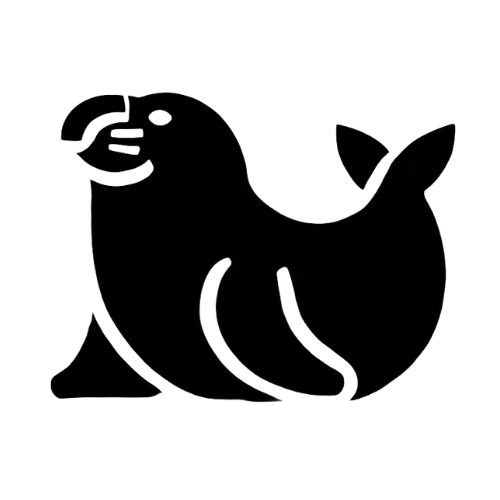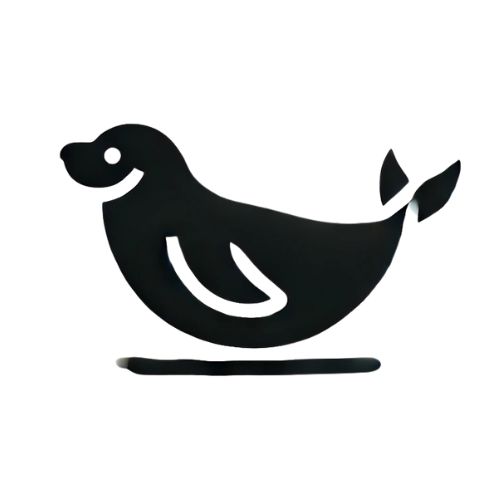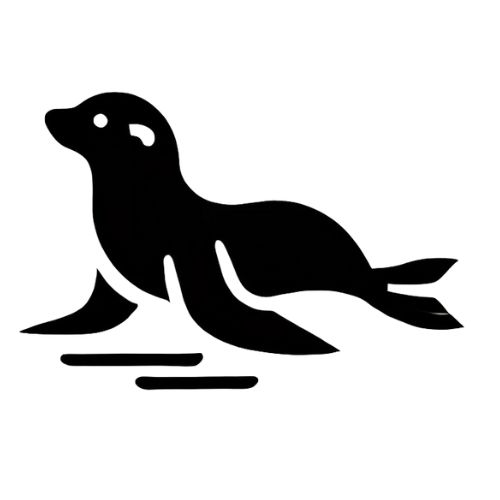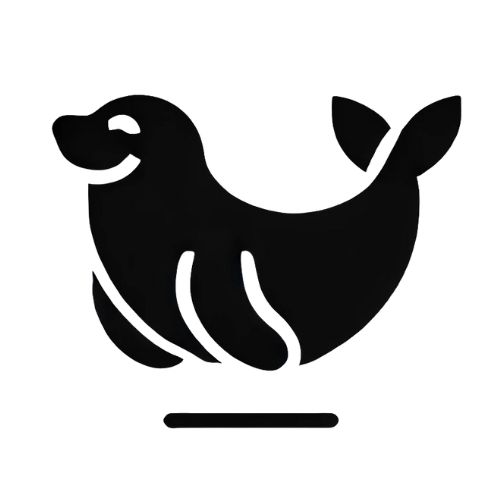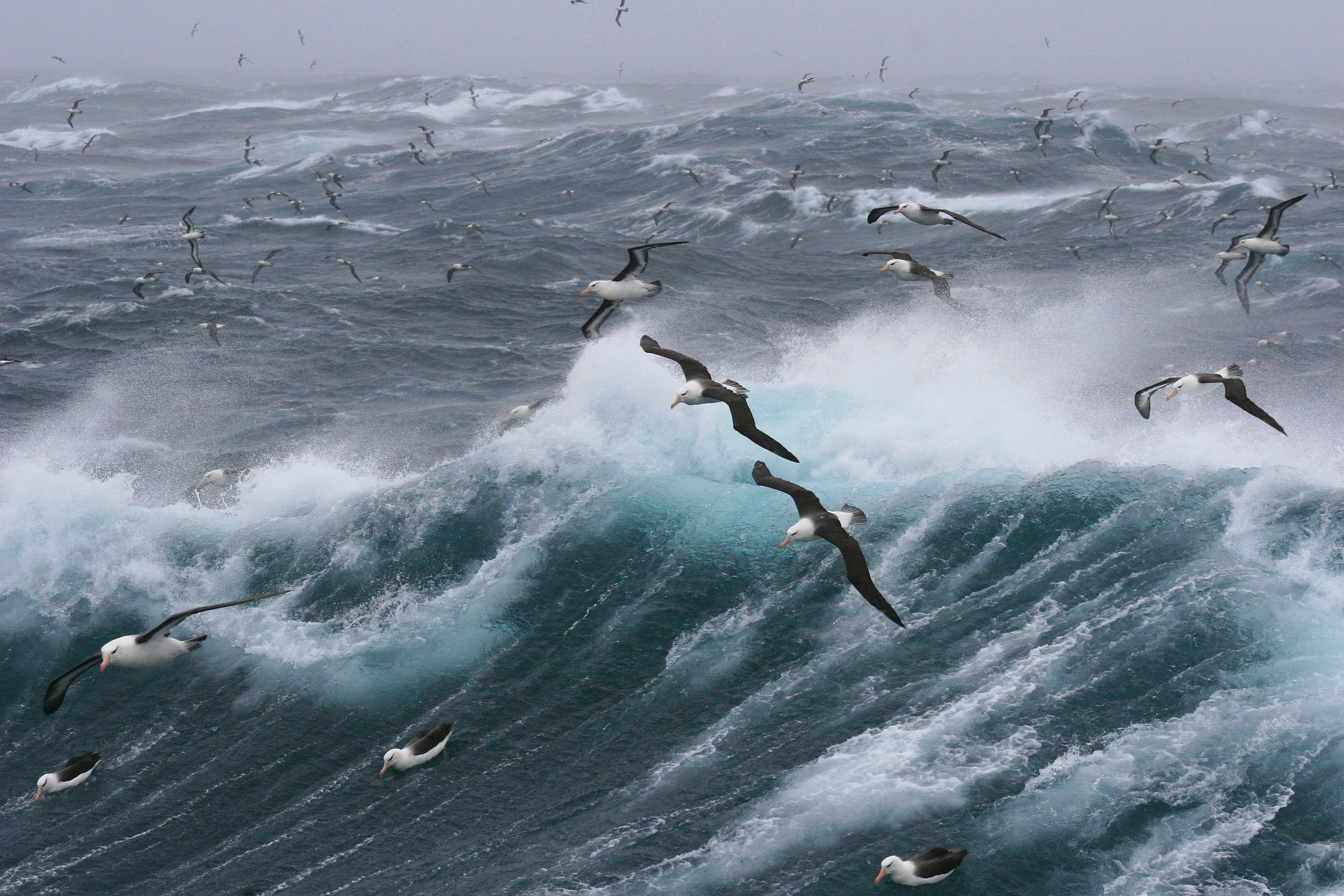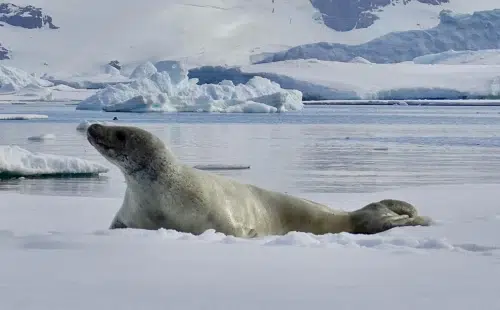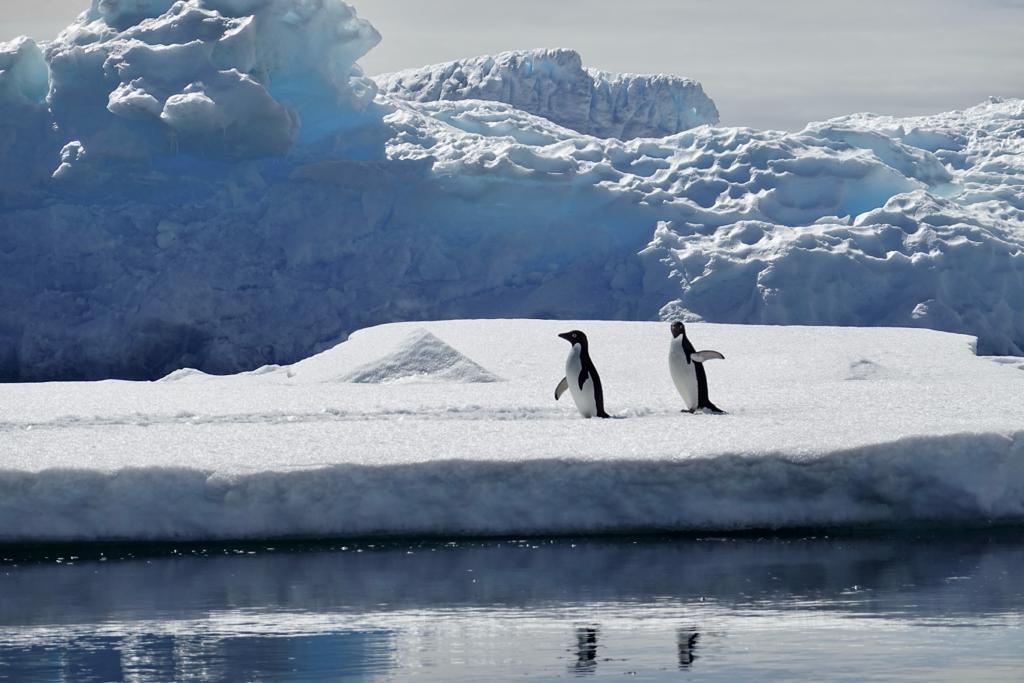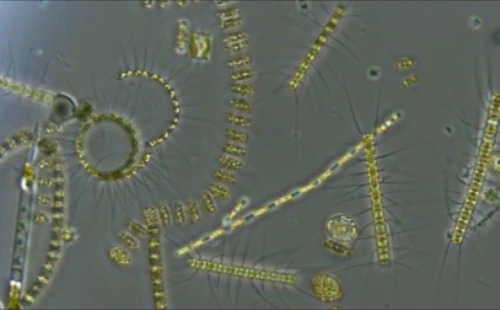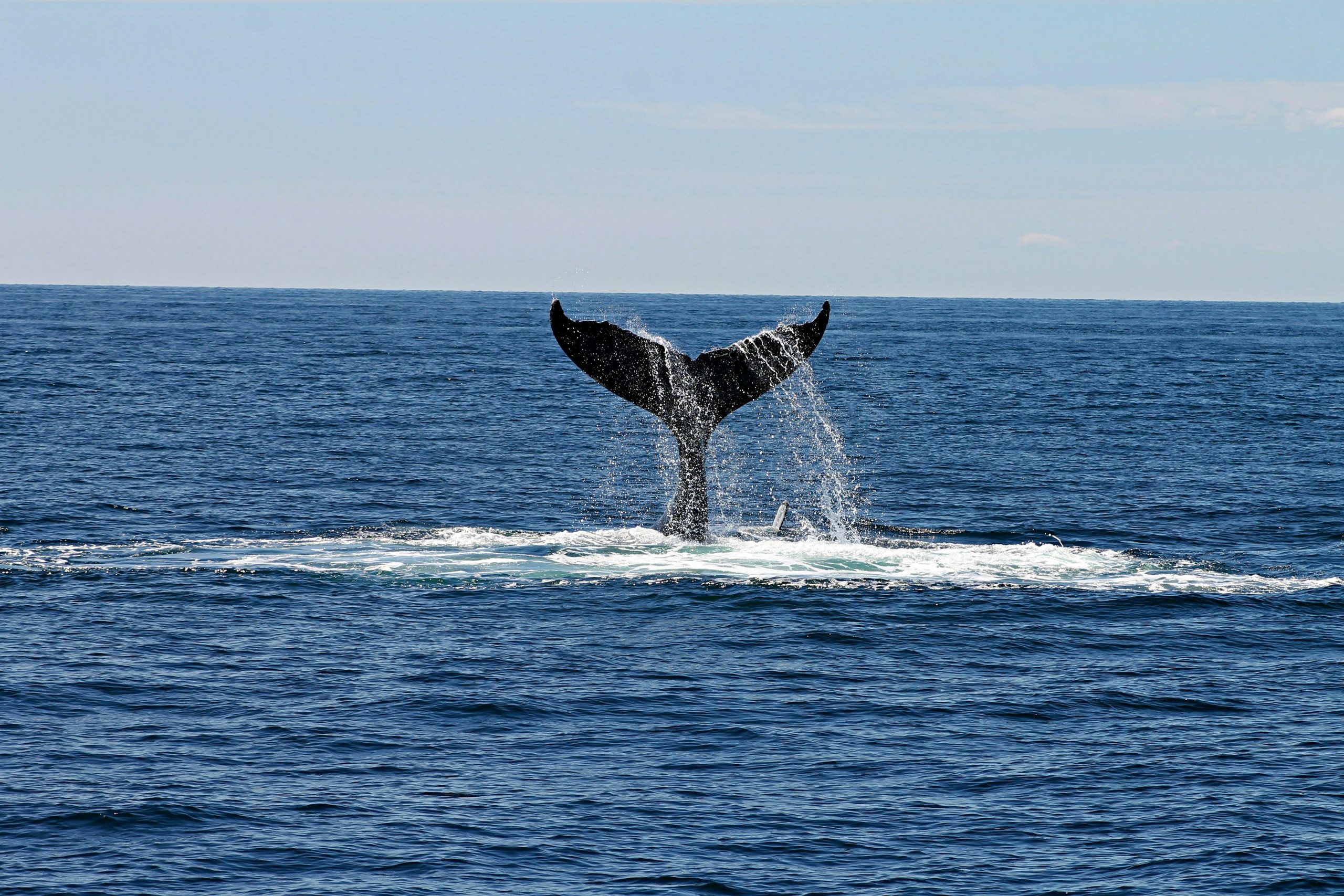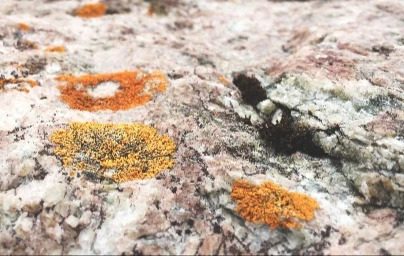Seals of Antarctica
Seals are a diverse group of marine mammals, uniquely adapted to life in the polar and subpolar oceans. Known for their streamlined bodies, insulating layers of blubber, and powerful flippers, seals are capable swimmers and deep divers. They play a crucial role in the marine ecosystem, feeding on fish, squid, and crustaceans, while also being prey for larger predators like orcas and sharks.
Among the various species, each type of seal has distinct characteristics and adaptations suited to its environment, from the Weddell seal’s ice-breaking abilities to the leopard seal’s specialized hunting techniques. These remarkable animals not only illustrate the resilience and adaptability required for survival in extreme environments but also contribute significantly to the ecological balance of their habitats.
Unique Adaptations of Antarctic Seals
Antarctic seals have evolved specialised adaptations that allow them to thrive in such a harsh environment. Their thick blubber provides insulation against the cold, while advanced diving abilities enable them to reach deep and distant prey. Additionally, their unique physiological mechanisms help them survive extended periods underwater, crucial for both foraging and escaping predators.
Breeding and Environmental Indicators
Breeding and pupping in Antarctic seals typically occur on stable sea ice, which offers some protection to their young from natural predators. Furthermore, seals in this region act as indicators of environmental changes. Shifts in sea ice cover and variations in prey availability—often driven by climate change—affect their populations and behaviours. Monitoring these changes provides scientists with valuable insights into the overall health of Antarctic ecosystems.
Elephant Seals (Mirounga leonina)
Elephant seals are among the largest members of the seal family, distinguished by their impressive size and unique characteristics. Male elephant seals are especially notable for their large, trunk-like noses, which give the species its name and play a role in producing loud, resonant vocalisations during mating season.
This distinct feature, along with their massive, muscular bodies, makes elephant seals stand out in the marine mammal community. Despite their bulk, these seals are adept swimmers and have adapted well to challenging environments, spending most of their lives at sea, far from the coast.
Adaptations for Deep-Sea Diving
Elephant seals are remarkable divers, capable of diving to extreme depths in search of food. They can hold their breath for extended periods, allowing dives that last over an hour and reach depths exceeding 1,500 metres. This diving capability sets them apart from other seals and enables them to access food sources deep in the ocean, free from competition with other predators.
At sea, they lead primarily solitary lives, covering vast distances while foraging alone across the open ocean.
Life Cycle and Haul-Out Behaviour
Elephant seals follow a unique annual cycle that includes extended periods at sea and brief but intense gatherings on shore, known as haul-outs. These haul-outs are essential for their lifecycle, as they involve moulting and mating periods. During this time, seals engage in complex social interactions and face significant physical demands, especially males, who compete aggressively for mates.
This cycle underscores a fascinating balance between solitary survival in the ocean and critical social interactions, reflecting their remarkable adaptations within the broader seal family.
Appearance
Elephant seals, among the most massive pinnipeds, are easily recognised by their large size and distinctive physical features. Males, called bulls, are especially imposing, weighing up to 4,000 kilograms (8,800 pounds) and reaching lengths of over 6 meters (20 feet).
The species derives its name from the male’s inflatable proboscis, a trunk-like structure used to produce loud, roaring sounds—particularly during the breeding season, when vocal displays signal dominance.
Both male and female elephant seals have thick, wrinkled skin, which darkens when wet and varies in colour from grey to brown. This robust skin helps protect them in the harsh marine environment, providing insulation and durability.
Behaviour
Elephant seals are exceptionally adapted to aquatic life, spending nearly 90% of their time in the ocean foraging for food. Known for their deep-diving abilities, they routinely dive to depths of 1,500 meters (4,900 feet) and can remain underwater for up to two hours.
Their time on land is marked by a strongly hierarchical social structure, especially in breeding colonies where dominant males, or bulls, establish control over harems of females. These territorial dynamics shape interactions within the colonies and play a crucial role in breeding success.
Diet
Elephant seals are primarily carnivorous, with a diet consisting of squid, fish, and various deep-sea organisms. Their exceptional diving capabilities are supported by specialised physiological adaptations, including high-capacity oxygen storage in their muscles.
This adaptation enables them to reach ocean depths where their prey resides, making them highly effective foragers on the seafloor. Their foraging patterns impact prey distribution and contribute to the balance of marine ecosystems.
Reproductive Cycle
The breeding season is marked by intense competition among males, with dominant bulls engaging in dramatic battles to secure and maintain control over harems. Successful bulls mate with multiple females, ensuring the continuation of their lineage.
After an eleven-month gestation period, females give birth to a single pup, which they nurse for approximately one month. Their milk is nutrient-dense, promoting rapid growth in pups. Shortly after weaning, females typically mate again, initiating a new reproductive cycle that supports the growth of the population.
Habitat & Range
Two species of elephant seals exist, each occupying distinct regions. The Northern elephant seal (*Mirounga angustirostris*) inhabits the North Pacific, breeding on islands off the coast of California and Baja California in Mexico. In contrast, the Southern elephant seal (*Mirounga leonina*) has a broader distribution across the Southern Hemisphere.
These southern populations breed on sub-Antarctic and Antarctic islands, with additional colonies found along the coasts of Argentina, South Africa, and New Zealand. This wide range reflects their adaptability to diverse marine environments, from temperate to sub-Antarctic waters.
Ecological Role
Elephant seals hold a pivotal role in their marine ecosystems, functioning as top predators that influence the distribution and behaviour of prey species. Their foraging activities help maintain ecological balance, and their population trends can provide insights into the health of ocean ecosystems.
Monitoring elephant seal habitats and migration patterns is critical for understanding the impacts of environmental changes, including climate shifts and ocean health. Conservation efforts focused on these seals are essential for safeguarding their populations and preserving the biodiversity of the marine environments they inhabit.
Back To Top
Weddell Seals (Leptonychotes weddellii)
Weddell seals are a remarkable species adapted to the extreme conditions of Antarctica, making them one of the few mammals able to thrive in such a harsh environment. Known for their stocky bodies covered in a thick layer of blubber, Weddell seals are well-equipped to handle freezing temperatures both on land and underwater.
Their adaptability and unique physiological traits enable them to survive where few other animals can, securing a niche within the icy waters surrounding the Antarctic continent.
Adaptations for Ice Environments
Weddell seals have evolved specialized abilities to navigate and survive within the frozen landscapes of Antarctica. These seals are adept at creating breathing holes in the ice, using their strong, sharp teeth to gnaw through thick layers. This skill is essential, as it allows them to access the ocean beneath the ice sheet, where they hunt and evade predators.
Despite the harsh surroundings, Weddell seals display an impressive level of endurance and skill in finding food sources, demonstrating an adaptability that sets them apart from other seals.
Unique Lifecycle and Social Behaviour
The lifecycle of Weddell seals revolves around the Antarctic seasonal changes, with key activities like mating and pupping aligned with warmer months. During the breeding season, they gather in small groups on the ice, where they engage in social interactions and establish territories. This social behaviour, coupled with their ability to survive long periods beneath the ice, showcases the complex balance between individual survival skills and group dynamics that defines Weddell seals within the diverse seal family.
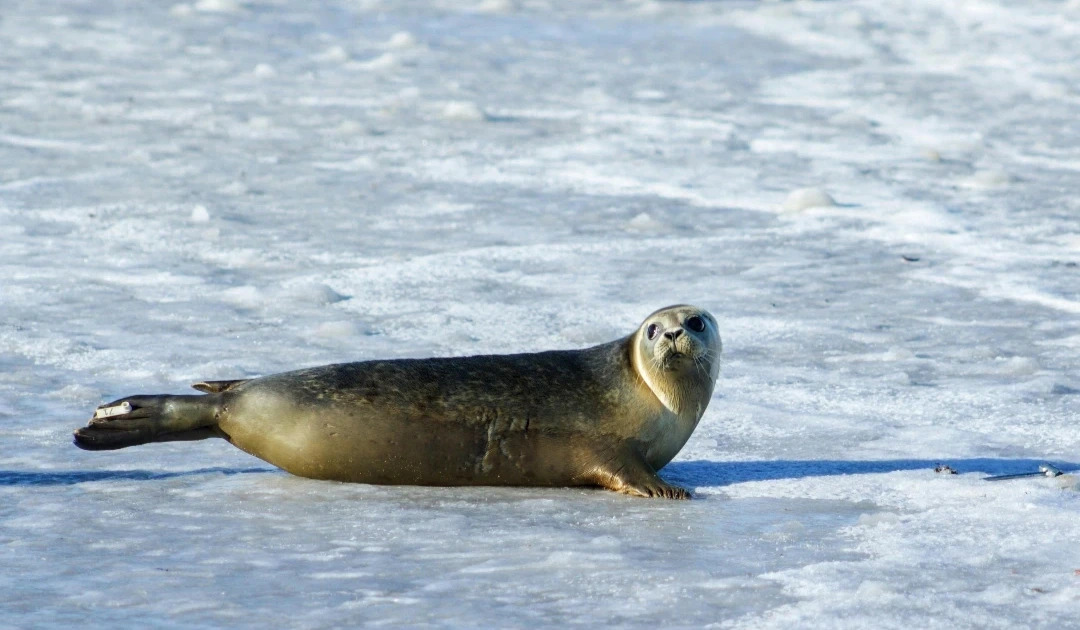
Appearance
Weddell seals, medium-sized pinnipeds, are easily recognisable by their distinct grey pelage covered in spots, which provides effective camouflage against the icy Antarctic landscape.
Adults can reach up to 3 meters (10 feet) in length and weigh between 400 and 600 kilograms (880 to 1,320 pounds), with females generally larger than males. Their robust bodies, small heads, and large, dark eyes are adapted for survival in the harsh polar environment.
These large eyes, designed to see in low-light conditions, enable Weddell seals to navigate the dim underwater world beneath the ice.
Behaviour
Highly adapted to the Antarctic’s icy terrain, Weddell seals spend much of their lives within and under ice-covered seas. Known for their exceptional diving abilities, they regularly reach depths exceeding 600 meters (1,970 feet) and can hold their breath for up to an hour.
One of their most remarkable behaviours is their use of strong, sharp teeth to create breathing holes in the ice, an adaptation essential for survival in frozen waters where access to air can be limited. These breathing holes allow Weddell seals to remain close to prey-rich areas under the ice while also evading predators.
Diet
Weddell seals are skilled hunters, feeding primarily on fish, squid, and krill, which they locate beneath the ice. Their sensitive whiskers, called vibrissae, help them detect movements in the water, even in the dark, murky conditions.
These seals forage at varying depths, both near the sea floor and in mid-water, using their large eyes and whiskers to track down prey. This versatile foraging behaviour supports their role as a vital link in the Antarctic food web, as they help regulate the populations of smaller marine organisms.
Reproductive Cycle
The breeding season for Weddell seals occurs from September to November, coinciding with the austral spring. During this period, females give birth to a single pup on the ice, which they nurse for about six weeks.
The mother’s milk is rich in fat, enabling pups to gain weight quickly and develop the strength needed for survival in the cold. Shortly after the weaning period, mating takes place underwater, starting the next reproductive cycle.
This cycle of birth and rapid pup growth is critical for maintaining stable populations in the challenging Antarctic environment.
Habitat & Range
Weddell seals inhabit the coastal areas of Antarctica, from the Antarctic Peninsula to the Ross Sea, including many surrounding islands. They have a strong association with pack ice, seldom straying far from this essential habitat.
Unlike many seal species that migrate seasonally, Weddell seals remain in Antarctic waters year-round, enduring the extreme winter cold.
Their resilience makes them one of the most southerly distributed mammals on Earth, occupying a unique niche in the Antarctic ecosystem.
Ecological Role
As one of the southernmost-dwelling mammals, Weddell seals are a key species within the Antarctic marine ecosystem. Their presence serves as an important indicator of ecosystem health, as their population dynamics can reflect changes in sea ice conditions and prey availability—factors influenced by climate change.
Ongoing research on Weddell seals contributes valuable insights into the Antarctic environment, helping scientists monitor the impacts of global warming and other environmental changes on polar ecosystems.
Conservation of Weddell seal populations remains essential for preserving the balance of life in the Southern Ocean, and their adaptability offers a remarkable example of survival in one of the world’s harshest environments.
Back To Top
Crabeater Seals (Lobodon carcinophaga)
Crabeater seals are among the most abundant seal species in the world, thriving in the icy waters surrounding Antarctica. Despite their name, crabeater seals do not primarily eat crabs; instead, their diet consists largely of krill, a small crustacean abundant in Antarctic waters.
Known for their slender bodies and distinctively adapted teeth, crabeater seals are uniquely suited to filter krill from the water, making them well-adapted to the rich marine ecosystem they inhabit. In the wild, crabeater seals typically live between 20 and 25 years. With an estimated population of around 15 million individuals, they are considered one of the most numerous large mammal species on Earth.
Adaptations for Krill Feeding
Crabeater seals possess specialized, interlocking teeth that enable them to filter krill efficiently, allowing them to capture these small crustaceans in large quantities. This unique adaptation sets them apart from other seal species and underscores their role in the Antarctic food web.
Their streamlined bodies and strong swimming abilities also aid in their pursuit of krill, making crabeater seals highly efficient foragers in Antarctic waters where food sources can be widely dispersed.
Life in Pack Ice and Social Dynamics
Living predominantly within the dense pack ice, crabeater seals are well-equipped to navigate and survive in challenging conditions. They rely on the ice for resting and birthing and are often found in small groups, particularly during the breeding season. Crabeater seals exhibit social behaviours when grouped on the ice, although they are primarily solitary while at sea.
This combination of solitary foraging and seasonal gatherings reflects a balanced lifestyle adapted to the unique demands of their icy habitat, highlighting the crabeater seal’s niche within the diverse seal population of Antarctica.
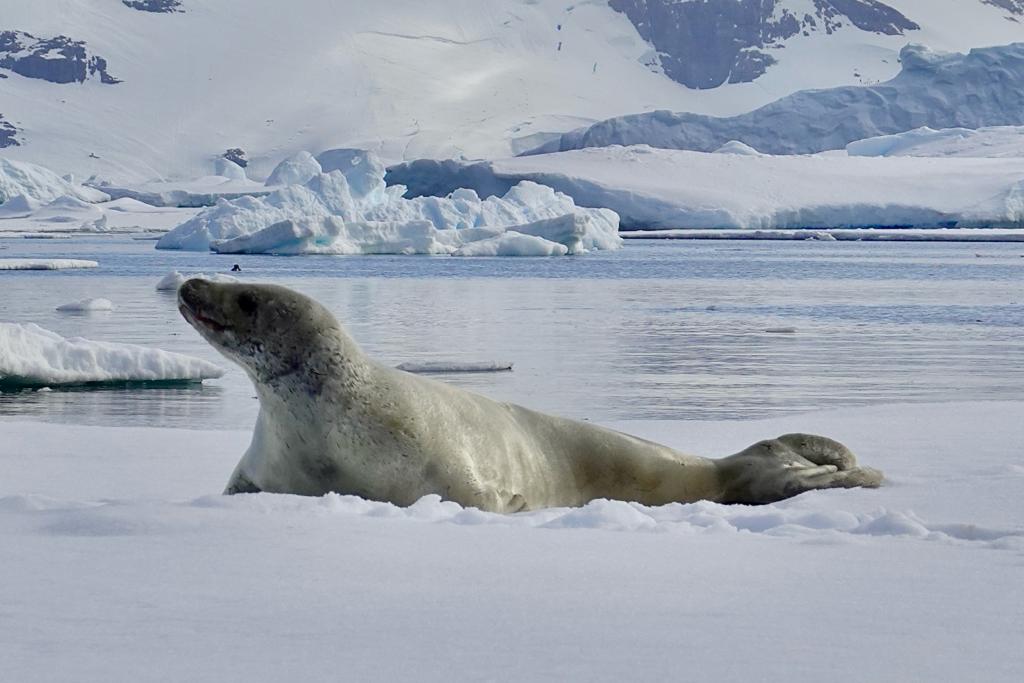
Appearance
Crabeater seals are slender, streamlined marine mammals well-suited to life in the icy Antarctic waters. Adult crabeaters typically reach lengths of up to 2.6 meters (8.5 feet) and weigh between 200 and 300 kilograms (440 to 660 pounds).
Their coats vary from silver-grey to pale yellow, becoming more mottled with age, which aids in camouflage against the snowy and icy landscape.
A unique feature of crabeater seals is their complex, interlocking teeth, specially adapted to filter their primary food source, krill, from seawater. These distinctive teeth allow them to efficiently consume large quantities of krill, making them a key part of the Antarctic ecosystem.
Behaviour
Crabeater seals are highly ice-dependent and spend the majority of their lives on the pack ice that surrounds Antarctica. Known for their social nature, they often gather in groups on the ice, especially during resting periods.
Despite their name, crabeater seals rarely, if ever, consume crabs; instead, they have adapted almost exclusively to a krill-based diet. They are also predominantly nocturnal, becoming most active at night for hunting and social activities. This behaviour may help them avoid some of their main predators, such as leopard seals, which are more active during the day.
Diet
The diet of crabeater seals is primarily composed of Antarctic krill, which they are uniquely equipped to capture using their specialised teeth. To feed, they draw water and krill into their mouths and then expel the water, trapping the krill against their serrated teeth.
This filtration mechanism enables crabeater seals to feed efficiently, allowing them to consume vast amounts of krill daily. By fulfilling this niche, they play an essential role in controlling krill populations, a crucial part of the Southern Ocean food web.
Reproductive Cycle
Crabeater seals breed from September to November, with females giving birth to a single pup on the ice floes.
The mother nurses her pup for approximately four weeks, providing nutrient-rich milk high in fat content. This rapid intake of calories helps the pup gain weight quickly and develop essential layers of blubber for insulation against the cold.
By the end of the nursing period, the pup is generally prepared for independent survival, marking the start of its journey in the harsh Antarctic environment.
Habitat & Range
Crabeater seals have a circumpolar distribution around Antarctica, with their habitat centred on the extensive pack ice that surrounds the continent. They are among the world’s most abundant seal species, an unusual distinction given the isolated and challenging nature of their environment.
This abundance is directly linked to their specialisation in feeding on krill, which allows them to thrive in vast numbers. However, their remote habitat on the drifting pack ice makes sightings by humans rare, adding an element of mystery to this widely distributed species.
Ecological Role
Crabeater seals are vital to the Antarctic ecosystem due to their role as major consumers of krill. By feeding on such large quantities of krill, they influence the population dynamics of this keystone species, impacting the entire marine food web.
Their presence also serves as an indicator of the health of krill populations, and by extension, the health of the Antarctic marine environment. Despite a name that suggests a diverse diet, crabeater seals embody ecological specialisation, showing how species adapt to the unique demands of the extreme Antarctic ecosystem.
Through their specialised feeding, social behaviours, and interactions with other species, crabeater seals demonstrate the intricate balance of the Antarctic ecosystem. Conservation of this species, alongside careful monitoring of krill populations, remains essential for maintaining the health and stability of the Southern Ocean’s marine environment.
Back To Top
Fur Seals (Arctocephalinae)
Fur seals are a fascinating group of marine mammals distinguished by their dense, double-layered coats, which provide excellent insulation in cold waters. These seals are highly adaptable and are found in sub-Antarctic and temperate regions, with the largest populations located around South Georgia and the South Shetland Islands.
Fur seals have an estimated population of over two million individuals, a testament to their resilience and adaptability. In the wild, they generally live between 12 and 20 years, although some individuals may live even longer under favourable conditions.
Adaptations for Cold Waters
The thick fur of fur seals is one of their defining features and an essential adaptation for survival in cold, challenging environments. Unlike other seals that rely primarily on a thick layer of blubber for insulation, fur seals have a dense underfur layer, protected by longer guard hairs, which traps a layer of air and helps retain warmth. This adaptation, combined with their strong swimming abilities, allows fur seals to hunt efficiently in cold waters where food sources can be widely distributed.
Social Structure and Life Cycle
Fur seals exhibit complex social structures, especially during the breeding season when they gather in large colonies on beaches. During this time, males establish and defend territories, engaging in aggressive displays and vocalisations to maintain their dominance and attract females. Females give birth to a single pup each year and provide dedicated maternal care until the pup is weaned.
This seasonal gathering and breeding behaviour showcases the social dynamics of fur seals and their adaptations to both solitary and communal life stages, highlighting their role within the broader seal population.
Appearance
Fur seals are distinguished by their thick, luxurious underfur, once highly sought by hunters and nearly driving the species to extinction. Their streamlined, robust bodies are well-suited for both aquatic and terrestrial environments, with notable size differences between the sexes.
Adult males can reach up to 2 meters (6.5 feet) in length and weigh between 200 to 300 kilograms (440 to 660 pounds), whereas females are significantly smaller. Unlike true seals, fur seals have external ear flaps and long, powerful front flippers, which they use for efficient propulsion in the water.
Their coats range in colour from dark brown to grey, with pups typically born with a distinctive black coat that fades as they mature.
Behaviour
Fur seals are highly social and form large colonies on rocky beaches and shores during the breeding season. These colonies can be highly dynamic, as the seals engage in social interactions and establish hierarchies.
In the water, fur seals are agile and strong swimmers, often spending months at sea on extended foraging trips. They rely on their muscular front flippers for speed and precision, allowing them to cover vast distances while foraging.
On land, fur seals are more mobile than true seals, able to move quickly and climb over rocky terrains with ease. This mobility gives them an advantage in navigating the rough, uneven landscapes of their breeding grounds.
Diet
Fur seals have a varied diet that includes fish, squid, and, on occasion, penguins. They are skilled hunters, capable of diving deeply and sustaining long underwater pursuits to capture prey.
Their pointed, sharp teeth are well-suited to grasping slippery prey, enabling them to feed efficiently even in challenging conditions.
Fur seals use their keen sense of sight and agility to locate and catch fast-moving prey, playing an essential role in regulating prey populations within their marine ecosystems.
Reproductive Cycle
During the breeding season, fur seals congregate in large numbers on breeding beaches, where males establish territories and assemble harems of females. These males become highly territorial and may display aggressive behaviour to defend their positions against rival males.
Each female typically gives birth to a single pup per year, and the maternal bond is notably strong. Mothers recognize their pups through a combination of vocalizations and scent, enabling them to reunite after foraging trips. This bond ensures the survival of the pup, who receives nutrient-rich milk from the mother, facilitating rapid growth during the early months of life.
Habitat & Range
Fur seals are distributed across both the Southern and Northern Hemispheres, with distinct species inhabiting different regions.
In the Southern Hemisphere, Antarctic fur seals (Arctocephalus gazella) and South American fur seals (Arctocephalus australis) are commonly found on sub-Antarctic islands and along the South American coast.
In the North Pacific, the Northern fur seal (Callorhinus ursinus) represents a northern counterpart, inhabiting coastal areas and islands in regions like Alaska and Russia. This wide distribution highlights their adaptability to various marine environments, from temperate to sub-Antarctic climates.
Ecological Role
Fur seals have made a remarkable recovery after facing near-extinction due to intense sealing activities in the 18th and 19th centuries. International conservation efforts, supported by strict wildlife management policies, enabled fur seal populations to rebound and reestablish themselves in their native habitats.
Today, fur seals are a common presence in their breeding colonies, where their interactions provide valuable insights into marine ecosystem dynamics. Their recovery underscores the effectiveness of conservation policies in protecting vulnerable species and illustrates the potential for successful wildlife management.
Fur seals not only contribute to marine biodiversity but also serve as an example of how targeted conservation efforts can lead to the revival of species once on the brink of extinction.
Back To Top
Leopard Seals (Hydrurga leptonyx)
Leopard seals are one of Antarctica’s top marine predators, known for their sleek, powerful bodies and impressive hunting skills. As the second-largest seal species in the region, they are well adapted to the icy waters of the Southern Ocean. Leopard seals are unique within the seal family for their highly varied diet, which includes penguins, fish, and krill, making them apex predators in their habitat.
With an estimated population of around 35,000 individuals, they are less common than other Antarctic seals. In the wild, leopard seals typically live up to 26 years, although some may reach their early 30s.
Adaptations for Predation
Leopard seals have distinct adaptations that make them effective hunters in Antarctic waters. They possess long, muscular bodies and powerful jaws equipped with sharp, complexly grooved teeth, which allow them to tear apart prey such as penguins and other seals. Unlike many other seal species, they are solitary hunters, often stalking prey near the edges of ice floes. Their streamlined bodies and strong swimming capabilities enable leopard seals to move swiftly and cover wide hunting territories, making them highly efficient and agile predators.
Social Behaviour and Seasonal Cycles
Although generally solitary, leopard seals gather in certain areas during the breeding season, where they may display social behaviours and vocalisations. During this time, females give birth to a single pup, nurturing it until it is ready to survive independently. These seals are less social than other species and rarely form large colonies.
However, their seasonal patterns and individualistic lifestyle showcase a unique balance between solitary habits and the brief yet critical interactions required for their reproductive cycle, underlining their distinct niche within the Antarctic ecosystem.
Appearance
Named for their spotted coats, which bear a striking resemblance to those of leopards, leopard seals are one of Antarctica’s most recognisable and formidable marine predators.
These seals rank as the second largest among Antarctic seals, only surpassed by the southern elephant seal in size. Adult leopard seals can reach up to 3.5 meters (11.5 feet) in length and weigh between 300 and 600 kilograms (660 to 1,320 pounds), with females typically larger than males.
Their unique reptilian-like head, along with a strong jaw and sharp, large teeth, sets them apart as one of the top predators in the region. Their powerful jaws and specialised teeth are designed for a carnivorous diet, making them highly efficient hunters.
Behaviour
Leopard seals are solitary and highly territorial animals known for their aggressive behaviour, particularly when hunting. Unlike most other Antarctic seals, they are less social and rarely form large groups, instead preferring an independent existence across Antarctic and sub-Antarctic waters.
Highly adaptable, leopard seals can be found in diverse habitats, from the open ocean to the edges of ice floes. Their streamlined bodies and powerful flippers make them agile swimmers, capable of propelling themselves at impressive speeds while in pursuit of prey.
Diet
As apex predators, leopard seals have a diverse and robust diet that includes fish, squid, penguins, and even other seals. Known for their unique hunting methods, leopard seals often lurk at the edge of ice floes, waiting for unsuspecting penguins to enter the water before launching a swift ambush.
Their powerful jaws and sharp teeth allow them to grip and shake prey until it is rendered into consumable pieces. This hunting technique, combined with their strength and agility, makes them one of the Antarctic’s most effective predators.
Their predatory behaviour helps regulate prey populations, playing a crucial role in maintaining the balance of the Antarctic marine ecosystem.
Reproductive Cycle
The solitary nature of leopard seals makes their reproductive cycle challenging to study in detail, but it is believed that breeding occurs during the Antarctic summer, from November to December.
Females give birth to a single pup on the ice floes, where they can care for it in relative isolation. The mother nurses the pup for about a month, during which the pup gains considerable weight from the nutrient-rich milk.
After this weaning period, the pup becomes increasingly independent, though it may remain in the vicinity of the mother for a time. This brief yet intensive parental care prepares the young seal for survival in the harsh Antarctic environment.
Habitat & Range
Leopard seals are widely distributed throughout the Antarctic and sub-Antarctic regions. They are commonly found along the coast of Antarctica and on the surrounding ice floes, yet their range can extend northward to include sub-Antarctic islands and occasionally reach as far as the southern coasts of South America, Australia, and New Zealand.
This broad distribution demonstrates their adaptability to various marine environments within the Southern Ocean and highlights their important role across these regions.
Ecological Role
The leopard seal’s position as a top predator makes it a vital component of the Antarctic ecosystem. By controlling populations of prey species such as fish, penguins, and other seals, leopard seals help maintain a balanced marine environment.
Their role within the ecosystem also offers insights into the health of the Antarctic food web, as fluctuations in their prey populations can reflect broader environmental changes. Conservation efforts and further research are essential to better understand the ecology and population dynamics of leopard seals, as well as to assess how changes in climate and human activity impact their habitats.
The formidable presence of leopard seals underscores the raw, untamed nature of the Antarctic wilderness, serving as a reminder of the powerful natural forces that shape this remote region. Protecting the leopard seal and understanding its ecological role remain crucial for preserving the integrity of the Antarctic marine ecosystem and the balance of life within these icy waters.
Back To Top
Ross Seals (Ommatophoca rossii)
Ross seals are one of the least known and least studied seal species in Antarctica, largely due to their preference for remote, dense pack ice far from human activity. As the smallest of the Antarctic seals, Ross seals are distinctive for their short, stocky bodies and large eyes, which give them a unique appearance.
Estimates suggest a population of around 130,000 individuals, though their elusive nature makes precise numbers challenging to determine. In the wild, Ross seals typically live for about 20 years, adapting well to the extreme cold of their isolated environment.
Specialized Adaptations for Ice Habitats
Ross seals have several adaptations that allow them to thrive in isolated pack ice environments. Their large eyes enhance their vision in low-light conditions, helping them hunt in the dimly lit waters beneath the ice. They also have powerful flippers and a robust layer of blubber for insulation, which helps them navigate the icy terrain and endure long periods in the frigid water.
Unlike other seals, Ross seals vocalise frequently, both on the ice and underwater, producing a range of unique sounds that may play a role in communication, especially in the vast, empty expanses of their habitat.
Solitary Lifestyle and Reproductive Behaviour
Ross seals are primarily solitary animals, spending most of their lives alone in the isolated pack ice. Unlike other seals, they do not form large colonies; instead, they come together only briefly during the breeding season. During this time, females give birth to a single pup, which they care for until it is ready to fend for itself. This solitary and minimalistic social structure, along with their elusive nature, contributes to the mystery surrounding Ross seals and highlights their unique adaptations within the Antarctic ecosystem.
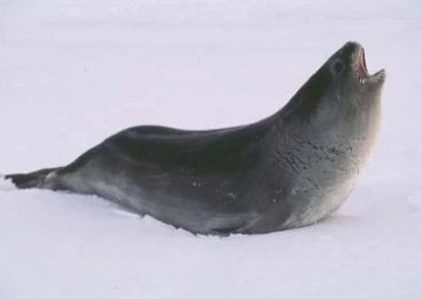
Appearance
The Ross seal stands out as one of the most distinctive yet least-studied seals of Antarctica. Smaller than other Antarctic seals, adult Ross seals measure between 2 and 2.5 meters (6.5 to 8.2 feet) in length and weigh approximately 150 to 215 kilograms (330 to 474 pounds).
Their dark, silvery-grey fur lightens around the belly, creating a unique contrast that aids in their camouflage within the icy habitat. One of their most notable features is their large, round eyes, which give them an expressive appearance and enhance their vision in the dim Antarctic waters.
Additionally, they display distinctive light and dark markings around the face and throat, setting them apart from other seal species and lending them a truly unique look in the Antarctic.
Behaviour
Ross seals are among the most elusive of Antarctic marine mammals, leading largely solitary lives within the dense pack ice. This reclusive behaviour, combined with their remote habitat, has limited scientific observation, leaving much of their behaviour and social structure undocumented.
However, one distinctive aspect of Ross seal behaviour is their vocalisation. Known for their siren-like calls and melodic chirps, Ross seals emit sounds both underwater and on the ice surface. These vocalisations are thought to play a role in communication, possibly during mating season, but remain largely mysterious due to the difficulty of studying these seals in their remote environment.
Diet
The diet of the Ross seal primarily includes squid and fish, with krill also making up a significant portion. While their exact foraging techniques are not well understood, their diet suggests that they forage in deep, ice-covered waters where these prey species are abundant.
The challenges of observing Ross seals in their natural habitat have left many aspects of their hunting behaviour undiscovered, though their large eyes and sensitive whiskers likely aid in locating prey in low-light conditions beneath the ice.
As with other Antarctic predators, Ross seals play a role in regulating the populations of their prey, helping to maintain balance within the food web.
Reproductive Cycle
Due to their solitary nature and preference for remote pack ice, little is known about the Ross seal’s reproductive cycle. It is believed that they give birth to a single pup during the Antarctic spring, around November, but details of their breeding behaviour, including courtship and weaning periods, remain largely unknown.
Observations suggest that the weaning period may be relatively short, with the mother providing rich, fatty milk to help the pup grow rapidly before it becomes independent. Further research is needed to fully understand the specifics of their reproductive habits, as these patterns hold key insights into the population dynamics and survival strategies of this secretive species.
Habitat & Range
Ross seals are closely associated with the high Antarctic pack ice, favouring the densest sea ice regions around the continent. Their distribution is most commonly noted in the Ross Sea, after which they are named, though they are also found along other coastal areas of the Antarctic continent.
This dependence on dense, stable sea ice sets Ross seals apart from other Antarctic seals and limits their range, confining them primarily to the regions with thick, year-round pack ice.
Their habitat choice reflects specialised adaptations to the extreme polar environment and highlights the importance of stable sea ice for their survival.
Ecological Role
The secretive nature and ice-dependent lifestyle of the Ross seal make it one of the least understood marine mammals in Antarctica. However, its presence is a critical reminder of the hidden biodiversity within the dense Antarctic ice pack.
As an ice-dependent species, the Ross seal is especially vulnerable to environmental changes driven by global warming, which threatens the stability and extent of Antarctic sea ice. Understanding the ecology of the Ross seal is essential, not only for conservation efforts focused on this species but also for broader initiatives aimed at preserving the Antarctic marine ecosystem.
The Ross seal’s life remains largely a mystery, and further research into its behaviour, foraging, and breeding is vital for conserving its unique place in the Antarctic. In a rapidly changing world, studying these reclusive seals will enhance our understanding of the Antarctic ecosystem’s resilience and help guide efforts to protect the continent’s most vulnerable species.
Back To Top

